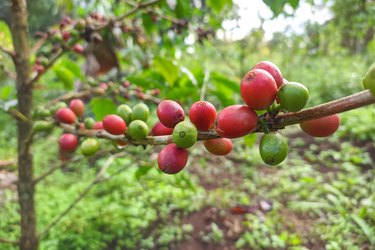
The coffee tree (Coffea, USDA plant hardiness zones 9 to 11) is a type of tropical evergreen shrub which grows best along the equator, where the climate is perfectly temperate and humid. If you're a coffee drinker, you may wish to educate yourself about the growth stages of coffee and what goes into making your perfect cup.
Coffee Plant Growth Stages
Video of the Day
While the lifespan of a coffee tree is around 20 years, it goes through several stages. It begins as a seed inside a cherry. When the cherry turns a deep purple color, it's ready to germinate. Germination is slow for all varieties. It can take up to three months for certain types.
Video of the Day
After germination, the first of the coffee plant growth stages is the juvenile stage. The trees are under 3 feet tall. In the wild, the mature tree canopies protect the younger ones from the strong sunlight. As the coffee trees approach full maturity, they begin to produce cherries and beans. It takes 15 weeks from fertilization for cherries to appear, and they need another seven to 11 months to fully develop.
A coffee tree can reach 30 feet tall by the time it's fully mature. However, most coffee cultivators keep their trees pruned shorter to preserve the tree's energy and direct it toward bean production. Most of these trees stop producing beans around age 20, although wild trees may continue to do so for an additional 10 years.
More Information About the Coffee Tree
The coffee tree is a genuinely tropical tree, so you won't see a lot of domestically-grown grounds. The only places to grow coffee in the United States are Hawaii, Puerto Rico and small parts of California.
Two significant types of coffee shrubs produce the main types of coffee. They are Coffea arabica, which has the arabica beans, and Coffea canephora, which makes robusta beans. However, there are more than 6,000 other shrubs in the same genus, with perhaps 25-100 producing coffee beans as we know them.
As you might expect, the tree plays an enormous role in the flavor of your cup of coffee. The varietal of your coffee bean's tree, where it's grown, its soil and the plants nearby can all impact how the grounds taste when they're brewed.
What Is the Average Lifespan of a Coffee Tree?
Coffee trees typically live about 20 years. Compared to the average lifespan of a tree, that may seem short, and it is a shorter life than many other types of trees. Part of the reason for this is how aggressively the beans are harvested. Coffee trees can live up to 100 years in the wild, but planters uproot and discard them because they stop producing beans around age 20.
During the coffee tree's 20 years, it will produce around 40,000 beans. That sounds like a lot, but when you consider that it takes several beans to make a single cup of coffee, you begin to understand why coffee production is such a massive industry.
Producing beans isn't a simple process for the tree, and it works hard during its 20 years of life.